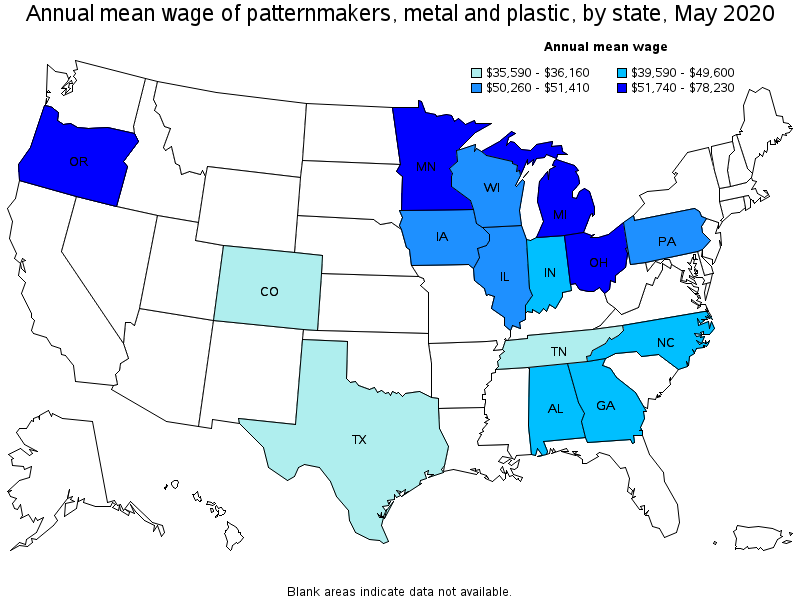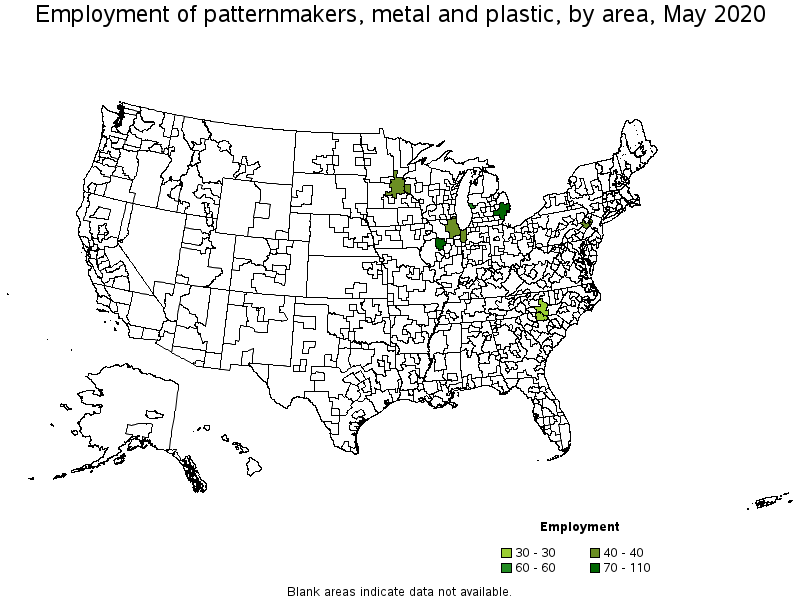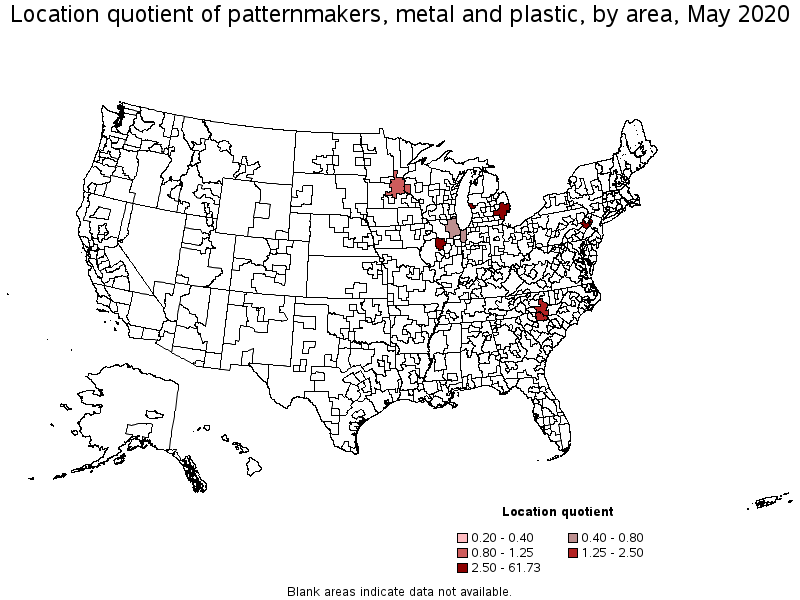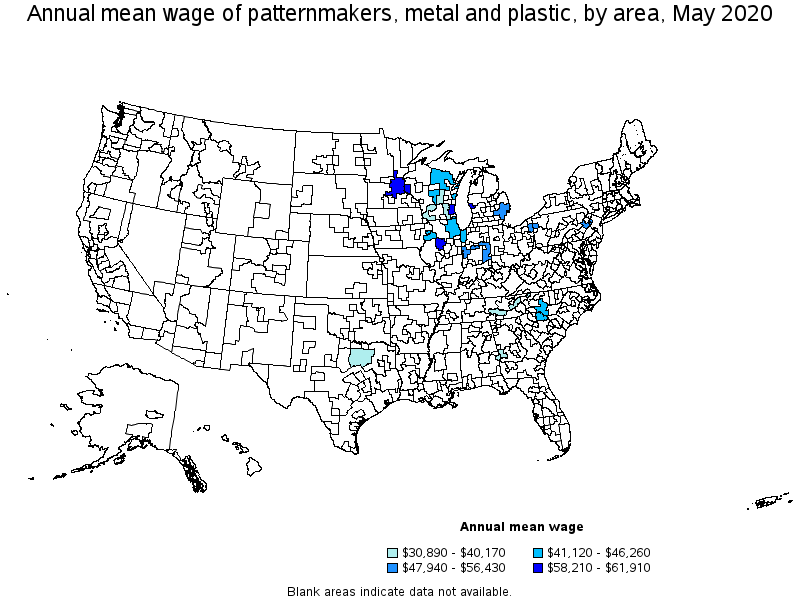An official website of the United States government
 United States Department of Labor
United States Department of Labor
Lay out, machine, fit, and assemble castings and parts to metal or plastic foundry patterns, core boxes, or match plates.
Employment estimate and mean wage estimates for Patternmakers, Metal and Plastic:
| Employment (1) | Employment RSE (3) |
Mean hourly wage |
Mean annual wage (2) |
Wage RSE (3) |
|---|---|---|---|---|
| 2,400 | 8.4 % | $ 23.83 | $ 49,570 | 2.2 % |
Percentile wage estimates for Patternmakers, Metal and Plastic:
| Percentile | 10% | 25% | 50% (Median) |
75% | 90% |
|---|---|---|---|---|---|
| Hourly Wage | $ 14.50 | $ 17.89 | $ 23.16 | $ 29.30 | $ 35.40 |
| Annual Wage (2) | $ 30,160 | $ 37,220 | $ 48,160 | $ 60,940 | $ 73,640 |
Industries with the highest published employment and wages for Patternmakers, Metal and Plastic are provided. For a list of all industries with employment in Patternmakers, Metal and Plastic, see the Create Customized Tables function.
Industries with the highest levels of employment in Patternmakers, Metal and Plastic:
| Industry | Employment (1) | Percent of industry employment | Hourly mean wage | Annual mean wage (2) |
|---|---|---|---|---|
| Foundries | 1,020 | 0.96 | $ 22.92 | $ 47,680 |
| Fabricated Metal Product Manufacturing (3321, 3322, 3325, 3326, and 3329 only) | 480 | 0.11 | $ 24.95 | $ 51,890 |
| Metalworking Machinery Manufacturing | 240 | 0.15 | $ 28.33 | $ 58,930 |
| Plastics Product Manufacturing | 170 | 0.03 | $ 19.14 | $ 39,810 |
| Machinery Manufacturing (3331, 3332, 3334, and 3339 only) | 60 | 0.01 | $ 23.44 | $ 48,760 |
Industries with the highest concentration of employment in Patternmakers, Metal and Plastic:
| Industry | Employment (1) | Percent of industry employment | Hourly mean wage | Annual mean wage (2) |
|---|---|---|---|---|
| Foundries | 1,020 | 0.96 | $ 22.92 | $ 47,680 |
| Metalworking Machinery Manufacturing | 240 | 0.15 | $ 28.33 | $ 58,930 |
| Fabricated Metal Product Manufacturing (3321, 3322, 3325, 3326, and 3329 only) | 480 | 0.11 | $ 24.95 | $ 51,890 |
| Plastics Product Manufacturing | 170 | 0.03 | $ 19.14 | $ 39,810 |
| Fabricated Metal Product Manufacturing (3323 and 3324 only) | 50 | 0.01 | $ 23.18 | $ 48,210 |
Top paying industries for Patternmakers, Metal and Plastic:
| Industry | Employment (1) | Percent of industry employment | Hourly mean wage | Annual mean wage (2) |
|---|---|---|---|---|
| Aerospace Product and Parts Manufacturing | 50 | 0.01 | $ 33.68 | $ 70,050 |
| Machine Shops; Turned Product; and Screw, Nut, and Bolt Manufacturing | (8) | (8) | $ 32.35 | $ 67,290 |
| Metalworking Machinery Manufacturing | 240 | 0.15 | $ 28.33 | $ 58,930 |
| Motor Vehicle Parts Manufacturing | 50 | 0.01 | $ 25.24 | $ 52,500 |
| Fabricated Metal Product Manufacturing (3321, 3322, 3325, 3326, and 3329 only) | 480 | 0.11 | $ 24.95 | $ 51,890 |
States and areas with the highest published employment, location quotients, and wages for Patternmakers, Metal and Plastic are provided. For a list of all areas with employment in Patternmakers, Metal and Plastic, see the Create Customized Tables function.

States with the highest employment level in Patternmakers, Metal and Plastic:
| State | Employment (1) | Employment per thousand jobs | Location quotient (9) | Hourly mean wage | Annual mean wage (2) |
|---|---|---|---|---|---|
| Wisconsin | 370 | 0.14 | 7.96 | $ 24.17 | $ 50,280 |
| Michigan | 270 | 0.07 | 3.93 | $ 27.52 | $ 57,250 |
| Illinois | 250 | 0.04 | 2.53 | $ 24.72 | $ 51,410 |
| Ohio | 240 | 0.05 | 2.69 | $ 24.87 | $ 51,740 |
| Pennsylvania | 170 | 0.03 | 1.77 | $ 24.16 | $ 50,260 |

States with the highest concentration of jobs and location quotients in Patternmakers, Metal and Plastic:
| State | Employment (1) | Employment per thousand jobs | Location quotient (9) | Hourly mean wage | Annual mean wage (2) |
|---|---|---|---|---|---|
| Wisconsin | 370 | 0.14 | 7.96 | $ 24.17 | $ 50,280 |
| Alabama | 130 | 0.07 | 3.98 | $ 23.14 | $ 48,140 |
| Michigan | 270 | 0.07 | 3.93 | $ 27.52 | $ 57,250 |
| Ohio | 240 | 0.05 | 2.69 | $ 24.87 | $ 51,740 |
| Indiana | 130 | 0.04 | 2.53 | $ 23.85 | $ 49,600 |

Top paying states for Patternmakers, Metal and Plastic:
| State | Employment (1) | Employment per thousand jobs | Location quotient (9) | Hourly mean wage | Annual mean wage (2) |
|---|---|---|---|---|---|
| Oregon | 40 | 0.02 | 1.27 | $ 37.61 | $ 78,230 |
| Minnesota | 50 | 0.02 | 1.09 | $ 28.59 | $ 59,470 |
| Michigan | 270 | 0.07 | 3.93 | $ 27.52 | $ 57,250 |
| Ohio | 240 | 0.05 | 2.69 | $ 24.87 | $ 51,740 |
| Illinois | 250 | 0.04 | 2.53 | $ 24.72 | $ 51,410 |

Metropolitan areas with the highest employment level in Patternmakers, Metal and Plastic:
| Metropolitan area | Employment (1) | Employment per thousand jobs | Location quotient (9) | Hourly mean wage | Annual mean wage (2) |
|---|---|---|---|---|---|
| Detroit-Warren-Dearborn, MI | 110 | 0.06 | 3.53 | $ 27.13 | $ 56,430 |
| Peoria, IL | 70 | 0.42 | 24.25 | $ 29.76 | $ 61,910 |
| Muskegon, MI | 60 | 1.06 | 61.73 | $ 29.30 | $ 60,940 |
| Chicago-Naperville-Elgin, IL-IN-WI | 40 | 0.01 | 0.55 | $ 21.30 | $ 44,290 |
| Minneapolis-St. Paul-Bloomington, MN-WI | 40 | 0.02 | 1.23 | $ 29.50 | $ 61,370 |
| Allentown-Bethlehem-Easton, PA-NJ | 40 | 0.11 | 6.21 | $ 23.05 | $ 47,940 |
| Charlotte-Concord-Gastonia, NC-SC | 30 | 0.03 | 1.56 | $ 21.67 | $ 45,080 |

Metropolitan areas with the highest concentration of jobs and location quotients in Patternmakers, Metal and Plastic:
| Metropolitan area | Employment (1) | Employment per thousand jobs | Location quotient (9) | Hourly mean wage | Annual mean wage (2) |
|---|---|---|---|---|---|
| Muskegon, MI | 60 | 1.06 | 61.73 | $ 29.30 | $ 60,940 |
| Peoria, IL | 70 | 0.42 | 24.25 | $ 29.76 | $ 61,910 |
| Allentown-Bethlehem-Easton, PA-NJ | 40 | 0.11 | 6.21 | $ 23.05 | $ 47,940 |
| Detroit-Warren-Dearborn, MI | 110 | 0.06 | 3.53 | $ 27.13 | $ 56,430 |
| Charlotte-Concord-Gastonia, NC-SC | 30 | 0.03 | 1.56 | $ 21.67 | $ 45,080 |
| Minneapolis-St. Paul-Bloomington, MN-WI | 40 | 0.02 | 1.23 | $ 29.50 | $ 61,370 |
| Chicago-Naperville-Elgin, IL-IN-WI | 40 | 0.01 | 0.55 | $ 21.30 | $ 44,290 |

Top paying metropolitan areas for Patternmakers, Metal and Plastic:
| Metropolitan area | Employment (1) | Employment per thousand jobs | Location quotient (9) | Hourly mean wage | Annual mean wage (2) |
|---|---|---|---|---|---|
| Peoria, IL | 70 | 0.42 | 24.25 | $ 29.76 | $ 61,910 |
| Minneapolis-St. Paul-Bloomington, MN-WI | 40 | 0.02 | 1.23 | $ 29.50 | $ 61,370 |
| Muskegon, MI | 60 | 1.06 | 61.73 | $ 29.30 | $ 60,940 |
| Milwaukee-Waukesha-West Allis, WI | (8) | (8) | (8) | $ 27.99 | $ 58,210 |
| Detroit-Warren-Dearborn, MI | 110 | 0.06 | 3.53 | $ 27.13 | $ 56,430 |
| Youngstown-Warren-Boardman, OH-PA | (8) | (8) | (8) | $ 24.35 | $ 50,650 |
| Allentown-Bethlehem-Easton, PA-NJ | 40 | 0.11 | 6.21 | $ 23.05 | $ 47,940 |
| Davenport-Moline-Rock Island, IA-IL | (8) | (8) | (8) | $ 22.24 | $ 46,260 |
| Charlotte-Concord-Gastonia, NC-SC | 30 | 0.03 | 1.56 | $ 21.67 | $ 45,080 |
| Chicago-Naperville-Elgin, IL-IN-WI | 40 | 0.01 | 0.55 | $ 21.30 | $ 44,290 |
These estimates are calculated with data collected from employers in all industry sectors, all metropolitan and nonmetropolitan areas, and all states and the District of Columbia. The top employment and wage figures are provided above. The complete list is available in the downloadable XLS files.
The percentile wage estimate is the value of a wage below which a certain percent of workers fall. The median wage is the 50th percentile wage estimate—50 percent of workers earn less than the median and 50 percent of workers earn more than the median. More about percentile wages.
(1) Estimates for detailed occupations do not sum to the totals because the totals include occupations not shown separately. Estimates do not include self-employed workers.
(2) Annual wages have been calculated by multiplying the hourly mean wage by a "year-round, full-time" hours figure of 2,080 hours; for those occupations where there is not an hourly wage published, the annual wage has been directly calculated from the reported survey data.
(3) The relative standard error (RSE) is a measure of the reliability of a survey statistic. The smaller the relative standard error, the more precise the estimate.
(8) Estimate not released.
(9) The location quotient is the ratio of the area concentration of occupational employment to the national average concentration. A location quotient greater than one indicates the occupation has a higher share of employment than average, and a location quotient less than one indicates the occupation is less prevalent in the area than average.
Other OEWS estimates and related information:
May 2020 National Occupational Employment and Wage Estimates
May 2020 State Occupational Employment and Wage Estimates
May 2020 Metropolitan and Nonmetropolitan Area Occupational Employment and Wage Estimates
May 2020 National Industry-Specific Occupational Employment and Wage Estimates
Last Modified Date: March 31, 2021